Spring Security 入门—内存用户验证
简介
作为 Spring 全家桶组件之一,Spring Security 是一个提供安全机制的组件,它主要解决两个问题:
- 认证:验证用户名和密码;
- 授权:对于不同的 URL 权限不一样,只有当认证的用户拥有某个 URL 的需要的权限时才能访问。
Spring Security 底层使用的是过滤器,针对 URL 进行的拦截,对应到 Java 中也就是类; 因此被称为粗粒度授权验证,就是验证 URL ,当前用户是否有这个 URL 的权限。
入门
创建项目
使用 Idea 创建 Spring Boot 项目,勾选需要的组件:
- Spring Web
- Spring Security
或者创建项目后添加依赖:
<dependency>
<groupId>org.springframework.boot</groupId>
<artifactId>spring-boot-starter-security</artifactId>
</dependency>
<dependency>
<groupId>org.springframework.boot</groupId>
<artifactId>spring-boot-starter-web</artifactId>
</dependency>
这里使用的是 JSP 作为模板,有关如何在 Spring Boot 中使用 JSP 作为模板请访问:https://www.cnblogs.com/cloudfloating/p/11787222.html
WebSecurityConfig
package top.cloudli.demo.security;
import org.springframework.context.annotation.Configuration;
import org.springframework.security.config.annotation.authentication.builders.AuthenticationManagerBuilder;
import org.springframework.security.config.annotation.method.configuration.EnableGlobalMethodSecurity;
import org.springframework.security.config.annotation.web.builders.HttpSecurity;
import org.springframework.security.config.annotation.web.configuration.EnableWebSecurity;
import org.springframework.security.config.annotation.web.configuration.WebSecurityConfigurerAdapter;
import org.springframework.security.crypto.bcrypt.BCryptPasswordEncoder;
import org.springframework.security.crypto.password.PasswordEncoder;
@Configuration
@EnableWebSecurity
@EnableGlobalMethodSecurity(prePostEnabled=true)
public class SecurityConfig extends WebSecurityConfigurerAdapter {
@Override
protected void configure(AuthenticationManagerBuilder auth) throws Exception {
PasswordEncoder encoder = new BCryptPasswordEncoder();
auth.inMemoryAuthentication()
.passwordEncoder(encoder)
.withUser("root")
.password(encoder.encode("root@123456"))
.roles("ROOT", "USER")
.and()
.withUser("user")
.password(encoder.encode("user@123456"))
.roles("USER");
}
@Override
protected void configure(HttpSecurity http) throws Exception {
http.authorizeRequests()
.antMatchers("/css/**")
.permitAll() // css 不用验证
.anyRequest()
.authenticated() // 其它页面全部需要验证
.and()
.formLogin() // 使用默认登录页面
.and()
.exceptionHandling()
.accessDeniedPage("/401") // 无权限时跳转的页面
.and()
.logout();
}
}
@EnableWebSecurity注解启用验证;@EnableGlobalMethodSecurity(prePostEnabled=true)注解允许我们在控制器的方法中使用@PreAuthorize实现权限分割。
此处创建了两个用户并保存在内存中,分别是拥有 ROOT 和 USER 权限的 root 用户和仅拥有 USER 权限的 user 用户。
fromLogin() 方法可以接着调用 loginPage() 指定一个自定义登录页面,这里使用的是默认登录页面。
编写页面
1.index.jsp,所有通过验证的用户都可以访问:
<%--
任何通过验证的用户都能访问的页面
--%>
<%@ page contentType="text/html;charset=UTF-8" language="java" %>
<html>
<head>
<title>Spring Security Demo Application</title>
<link rel="stylesheet" type="text/css" href="css/style.css">
</head>
<body>
<div class="content">
<h1>Spring Security In Memory Authentication</h1>
<h2>这是被保护的页面(ROLE_USER)。</h2>
</div>
</body>
</html>
2.root.jsp,只有拥有 ROOT 权限的用户能访问:
<%--
需要 ROLE_ROOT 才能访问的页面
--%>
<%@ page contentType="text/html;charset=UTF-8" language="java" %>
<html>
<head>
<title>Root Page</title>
<link rel="stylesheet" type="text/css" href="css/style.css">
</head>
<body>
<div class="content">
<h1>Root Page</h1>
<h2>你正在访问受保护的页面(ROLE_ROOT)。</h2>
</div>
</body>
</html>
3.401.jsp,没有权限时跳转的页面:
<%--
权限不够时跳转的页面
--%>
<%@ page contentType="text/html;charset=UTF-8" language="java" %>
<html>
<head>
<title>401 Unauthorized</title>
<link rel="stylesheet" type="text/css" href="css/style.css">
</head>
<body class="error">
<div class="content">
<h1>401 Unauthorized!</h1>
<h2>你没有权限访问此页面。</h2>
</div>
</body>
</html>
控制器
package top.cloudli.demo.controller;
import org.springframework.security.access.prepost.PreAuthorize;
import org.springframework.stereotype.Controller;
import org.springframework.web.bind.annotation.GetMapping;
@Controller
public class DemoController {
@PreAuthorize("hasAnyAuthority('ROLE_USER')")
@GetMapping("/")
public String index() {
return "index";
}
@PreAuthorize("hasAnyAuthority('ROLE_ROOT')")
@GetMapping("/root")
public String root() {
return "root";
}
@GetMapping("/401")
public String accessDenied() {
return "401";
}
}
@PreAuthorize 注解指定了访问页面所需要的权限,这里的权限要加上 ROLE_ 前缀。
Run
访问 http://localhost:8080/ 将进入登录页面(这里使用的是 Spring Security 的默认登录页面):

使用刚才创建的内存用户 user 登录后将返回 index 页面:

访问 http://localhost:8080/root,由于 user 用户没有 ROLE_ROOT 权限,跳转到 401 页面:

访问 http://localhost:8080/logout 将进入默认登出页面:

这里的登录和登出页面均可以使用自定义页面,只需要在自定义的页面中把数据通过 PSOT 请求提交到 /login 或 /logout 即可完成登录和登出。
Spring Security 入门—内存用户验证的更多相关文章
- Spring security 浅谈用户验证机制
step1:首先ApplicationUserDetailsService需要实现UserDetailsService接口(在 org.springframework.security.core.us ...
- 030 SSM综合练习06--数据后台管理系统--SSM权限操作及Spring Security入门
1.权限操作涉及的三张表 (1)用户表信息描述users sql语句: CREATE TABLE users ( id ) DEFAULT SYS_GUID () PRIMARY KEY, email ...
- SpringBoot集成Spring Security入门体验
一.前言 Spring Security 和 Apache Shiro 都是安全框架,为Java应用程序提供身份认证和授权. 二者区别 Spring Security:重量级安全框架 Apache S ...
- Spring Security 入门(基本使用)
Spring Security 入门(基本使用) 这几天看了下b站关于 spring security 的学习视频,不得不说 spring security 有点复杂,脑袋有点懵懵的,在此整理下学习内 ...
- Spring security 获取当前用户
spring security中当前用户信息 1:如果在jsp页面中获取可以使用spring security的标签库 在页面中引入标签 1 <%@ taglib prefix=" ...
- Spring Security 入门(1-7)Spring Security - Session管理
参考链接:https://xueliang.org/article/detail/20170302232815082 session 管理 Spring Security 通过 http 元素下的子元 ...
- Spring Security 入门(1-3-1)Spring Security - http元素 - 默认登录和登录定制
登录表单配置 - http 元素下的 form-login 元素是用来定义表单登录信息的.当我们什么属性都不指定的时候 Spring Security 会为我们生成一个默认的登录页面. 如果不想使用默 ...
- Spring Security入门(2-3)Spring Security 的运行原理 4 - 自定义登录方法和页面
参考链接,多谢作者: http://blog.csdn.net/lee353086/article/details/52586916 http元素下的form-login元素是用来定义表单登录信息的. ...
- Spring Security默认的用户登录表单 页面源代码
Spring Security默认的用户登录表单 页面源代码 <html><head><title>Login Page</title></hea ...
随机推荐
- 004-OpenStack-计算服务
OpenStack-计算服务 [基于此文章的环境]点我快速打开文章 1.控制节点(controller) 1.1 创库授权 nova_api, nova, 和 nova_cell0 mysql CR ...
- [Python]使用生成器来简化代码
原本只是大概知道生成器是什么,但一直不知道怎么用,或是什么情景下用,后来才发现: 在需要一边读数据一边处理任务时,如果直接为每个任务都写一个函数,那么读数据的部分就要在每个函数都重复一遍 直接将所有任 ...
- 跟着ALEX 学python day2 基础2 模块 数据类型 运算符 列表 元组 字典 字符串的常用操作
声明 : 文档内容学习于 http://www.cnblogs.com/xiaozhiqi/ 模块初始: Python的强大之处在于他有非常丰富和强大的标准库和第三方库,几乎你想实现的任何功能都有相 ...
- Spring(005)-多环境Profile
多个环境下的配置应该怎么进行,比如数据库连接字符,多个环境不同,spring的方案,大概总结如下. 例子,数据库配置. 定义一个获取数据库链接的接口 public interface DataConn ...
- 201871010117--石欣钰--《面向对象程序设计(java)》第十六周学习总结
博文正文开头格式:(2分) 项目 内容 这个作业属于哪个课程 https://www.cnblogs.com/nwnu-daizh 这个作业的要求在哪里 https://www.cnblogs.com ...
- 20187101021-王方《面面相对象程序设计java》第十三周实验总结
项目 内容 这个作业属于哪个课程 https://www.cnblogs.com/nwnu-daizh/ 这个作业的要求在哪里 https://www.cnblogs.com/nwnu-daizh/p ...
- 搭建pikachu平台及暴力破解
一.先将Pikachu文件放在网站根目录下 二.修改pikachu网站的配置文件 inc/config.inc.php define('DBUSER', 'user'); define('DBPW' ...
- MySQL数据库 存储引擎,创建表完整的语法,字段类型,约束条件
1.存储引擎 - 存储引擎是用于根据不同的机制处理不同的数据. - 查看mysql中所有引擎: - show engines; - myisam: 5.5以前老的版本使用的存储引擎 - blackho ...
- 7.Vue的计算属性
1.什么是计算属性 computed:计算属性的重点突出在 属性 两个字上(属性是名词),首先它是个 属性 其次这个属性有 计算的能力(计算是动词),这里的 计算 就是个函数:简单点说,它就是一个能够 ...
- 【转】Java代码编译过程简述
转载:https://blog.csdn.net/fuzhongmin05/article/details/54880257. 代码编译是由Javac编译器来完成,流程如下图1所示: 图1 Javac ...
